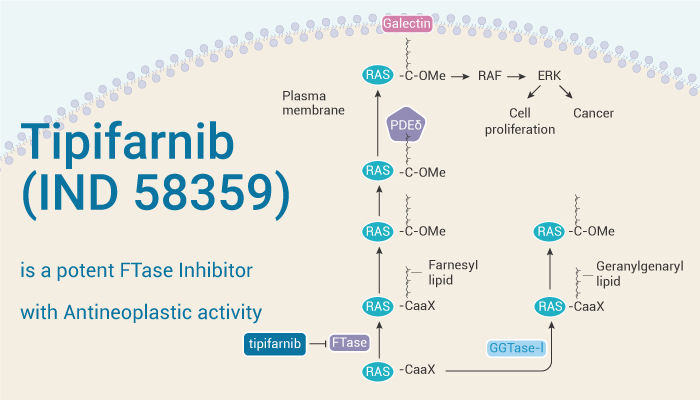Ras proteins play a crucial role in tumor diseases. Farnesylation is an important post-translational modification of Ras proteins. Whereas, that determines the oncogenicity and membrane-binding properties of Ras. Meanwhile, Farnesyltransferase (FTase) is responsible for the transfer of farnesyl groups to Ras. FTase activates the Ras and RhoB families. However, RAS decides the fate of Prostate cancer (PCa). Farnesyltransferase also catalyzes the lipid modification of cysteine residues, which farnesylate proteins lead to inflammation. Here, we introduce a potent FTase inhibitor, Tipifarnib.
Tipifarnib inhibits FTase to exert anti-tumor, anti-inflammatory and anti-infective activities.

In a word, Tipifarnib inhibits isolated human farnesyltransferase. After all, it inhibits lamin B peptide and K-RasB peptide with IC50s of 0.86 nM and 7.9 nM, respectively. Firstly, Tipifarnib (0.25 μM, 1 μM; 48 h) has antitumor activity. Specifically, it inhibits cell growth or angiogenesis, and induces apoptosis in aggressive prostate cancer. In addition, it (1.25-5 μM; 30 min) promotes endoplasmic reticulum stress in U937 cells. Therefore, leads to dysregulation of intracellular calcium homeostasis. Moreover, it causes plasma milk Ca2+ influx and increased [Ca2+]i levels, leading to apoptosis. In fact, Tipifarnib deregulates [Ca2+]i in a mitochondrial and ER-independent manner. The process is also associated with the activation of plasma membrane Ca2+ channels. Also, Tipifarnib is a potent Trypanosoma Cruzi inhibitor with an ED50 of 4 nM.
Tipifarnib (10 mg/kg; ip; single dose) attenuates liver injury and mortality in the GalN/LPS-challenged mouse model. It also upregulates the anti-apoptotic protein Bcl-xL in the liver. At the same time, it inhibits Caspase 3 activation and upregulates anti-apoptotic proteins to protect primary hepatocytes from GalN/TNF-α-induced cell death. Therefore, FTase inhibitors may prevent hepatocyte death and acute inflammatory liver failure in fulminant hepatitis.
Taken together, Tipifarnib is an inhibitor with multiple inhibitory activities. It can be widely used in the research of cancer, infection, and inflammation.
References:
[1] Devendra S Puntambekar, et al. J Enzyme Inhib Med Chem. 2007 Apr;22(2):127-40.
[2] End DW, et al. Cancer Res. 2001 Jan 1;61(1):131-7.
[3] Amrita Datta, et al. Sci Rep. 2018 May 25;8(1):8161.
[4] Yanamandra N, et al. J Pharmacol Exp Ther. 2011 Jun;337(3):636-43.
[5] Shirozu K, et al. Shock. 2014 Dec;42(6):570-577.